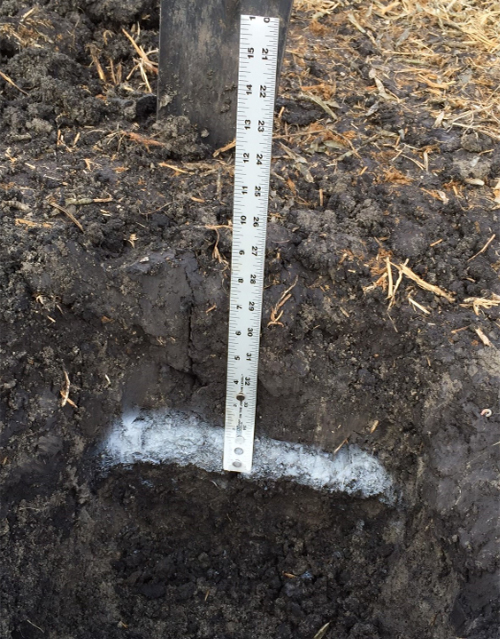
A simple exercise can help you identify hard pan in your fields.
BY CASE IH
Wet fields are likely hindering your harvest right now, so locating and breaking up hard pan during postharvest tillage will be important to help improve moisture management heading into next year and beyond.
No matter how you’re fixed for moisture, seedbed preparation needs to start now, and compaction management should be a part of it. In areas experiencing excess moisture, compaction layer management can help fields disperse moisture throughout the growing season. It’s a good practice in dry fields, too, as shattering hard pan will allow moisture and nutrients to move deeper in the soil profile so plants reach them if dry conditions occur.
Here’s a quick, easy way to check for compaction layer
In the photo, the bottom of the compaction layer (white line) is 9 inches deep, with the top of the compaction layer approximately 6 to 7 inches deep, resulting in a 2- to 3-inch-thick layer. To check the hard pan in your fields, use a spade to dig a hole about 16 inches deep (roughly the size of a 5-gallon bucket). Take a pocket knife and stick it into the side wall and pull the knife upward until you feel a resistance change. It will be abrupt in most cases. The bottom of the compaction layer can generally be found from 8 to 10 inches deep. This leaves about 6 inches of working soil above the compaction layer.
In wet conditions like we’ve seen this year, we need to break up the hard pan so water isn’t suspended in that top 6 inches of working soil. We want the excess moisture to be able to move vertically, rather than horizontally. In addition to clearing the way for deeper movement into the soil profile, this also allows the excessive moisture to find tile lines quicker.
Equipment running through these wet conditions may have created ruts in your field as well. Fall tillage can help to level these out, but it’s important not to create further compaction in the process. Check for compaction layers not only before, but during fall tillage. It’s natural to want to get through each field as quickly as possible, but it’s helpful to avoid using tools like heavy high-speed compact disks that have excessive blade angles, leave an uneven seedbed floor, and do not work up the entire soil profile, which can contribute to compaction.
In this photo, compaction has been created beneath each blade on a high speed disk tillage tool.
Busting the hard pan
The Case IH Ecolo-Tiger® 875 disk ripper fractures the hard pan across the entire implement, leaving the soil with an even density, ready to accept moisture and nutrients, and support strong root development. Here are some of the features that help make the Ecolo-Tiger 875 the ideal fall-tillage tool:
- The 24- or 26-inch disk blades handle heavy residue by cutting and mixing the top 3-4 inches of soil.
- Parabolic shanks outfitted with Case IH Tiger Points — adjusted to run 1 inch below the bottom of the hard pan — lift, twist and roll compaction.
- A 24-inch shank spacing provides even clod sizing by preventing large slabs from moving up to the surface.
- The Case IH disk leveler fills the void left by the shank and evenly distributes soil and residue across the soil surface.
The Case IH TigerPaw™ Crumbler® provides the perfect finish. Forged double-edge steel bars help the TigerPaw break up clods and root balls and size to 6 inches in diameter or less. Finally, the TigerPaw Crumbler tucks residue into the soil, providing good soil-to-residue contact for improved residue deterioration. Other finishing harrow options include a 30-inch-long coil tine harrow or a spike tooth harrow.
With the hard pan broken up and crop residue properly sized and mixed, you can work with your Case IH dealer over the winter to select the best tillage options to help you create a high-efficiency seedbed ahead of planting. Meanwhile, stay patient while you wait for fields to dry, and above all, stay safe during harvest.
LEARN MORE HERE
Harvest Report: No Substitute for Tiger Points
Brochure: Ecolo-Tiger 875 disk ripper